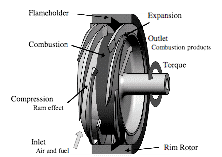Due to the high pressure and temperature state produced by shock waves, they offer the possibility to greatly speed up combustion processes as compared to diffusive reaction mechanisms. Devices exploiting shock-induced combustion also have the potential for higher compression ratios, and thus better efficiency, and less complexity than systems using mechanical compression systems. These advantages can lead to lighter, more efficient and more compact propulsion and power systems.
A traveling detonation wave is an example of a combustion process coupled to a shock wave, and it is relatively simple to produce in practice, usually in constant section tubes. This phenomenon is used in the pulsed detonation engine (PDE) propulsion concept, which exploits unsteady detonation propagation in the production of cyclic thrust [1].
However, most propulsion and power system applications ideally require a steady release of energy. The unsteady aspects of detonation wave propagation can be smoothed out by having the detonation propagate in a direction perpendicular to that of the main flow, as in rotating detonation wave (RDE) engines [2]. In concept, however, it would be much simpler to just stabilize the detonation at a fixed location in space in a supersonic pre-mixed reactive flow, and many designs have been proposed to achieve this. A fundamental parameter for detonations is obviously the Chapman-Jouguet (CJ) detonation velocity, and to successfully stabilize a normal detonation would require the flow to be supplied at exactly the CJ velocity for the mixture under consideration. A greater range of allowable velocities are possible in theory if the flow velocities exceed the CJ value, in which case an oblique detonation would be produced. Many analytical and numerical studies have demonstrated the feasibility of stabilizing oblique detonations, and this has been experimentally observed over moving projectiles [3,4]; this, however, has never has been conclusively demonstrated where the wave is actually at rest in the laboratory.
Nevertheless, even if stationary detonations prove to be elusive, many experiments have observed combustion phenomena following stationary shock waves [5]. For these cases, either a stationary normal shock, an oblique shock or a system of shocks is produced in a supersonic premixed reactive flow, and the shocks are used to compress and ignite the mixture. For these cases the reactive zone is not coupled as closely to the shocks as in a detonation wave but is coupled nonetheless, therefore retaining many of the advantages of detonation waves.
Towards that end, we present a novel engine concept exploiting shock-induced combustion to significantly improve power density and reduce complexity over conventional gas turbines, thus making it an interesting alternative for future transportation and stationary power systems. Simply described, this novel engine comprises a plurality of ramjets arranged tangentially around the periphery of a single rotor, as shown in Figure 1. In the rotating frame of reference, the premixed reactive mixture is first compressed by an oblique shock diffuser, which also ignites the flow. Combustion takes places behind the shock system in a rotating combustion chamber and the combustion products are then expanded in a convergent-divergent nozzle to reach supersonic velocities at the exit. The difference in momentum flux between the inlet and outlet produces thrust, as in a ramjet, which is converted to torque, and thus mechanical power, by the rotor. The whole thermodynamic cycle is achieved in a single rotating stage, dramatically reducing the number of parts as compared with a conventional gas turbine. Rotating ramjets have been proposed in the past, without actual success, but the present concept introduces two key features that ensure the viability of the concept.

Figure 1. Schematic of the rim–rotor rotary ramjet engine (R4E)
The first key enabling feature is the use of a high-strength carbon fibre rim wrapped around the rotor to load the blades in compression under the high centrifugal loads generated at the required supersonic tip speeds. Loading the blades in tension allow the use of ceramic materials which offer high-temperature operation capabilities, which increase the efficiency of the engine and reduce the cooling requirements. The second enabling feature is a rotating combustion chamber whose geometry correctly exploits the high-centrifugal-acceleration field created by the rotation to greatly reduce the length of the combustion zone, which allows for a compact rotor.
This paper presents the key compressible flow and combustion dynamics features of this novel engine and reports on tests with a proof-of-concept prototype which shows good agreement with the flow models. These results confirm the viability of the concept.
References
[1] K. Kailasanath (2003) Recent Developments in the research on pulse detonation engines. AIAA Journal 41(2):145-159
[2] K. Kailasanath (2011) The rotating-detonation-wave engine concept: A brief status report. 49th AIAA Aerospace Sciences Meeting 4 - 7 January 2011, Orlando, Florida
[3] M.J. Kaneshige, J.E. Shepherd (1996) Oblique detonation stabilized on a hypervelocity projectile. Twenty-Sixth Symposium (International) on Combustion/The Combustion Institute, pp. 3015–3022
[4] J. Verreault, A.J. Higgins (2011) Initiation of detonation by conical projectiles. Proceedings of the Combustion Institute 33:2311–2318
[5] C. I. Morris, M. R. Kamel, R. K. Hanson (1998) Shock-induced combustion in high-speed wedge flows. Twenty-Seventh Symposium (International) on Combustion/The Combustion Institute, pp. 2157–2164

